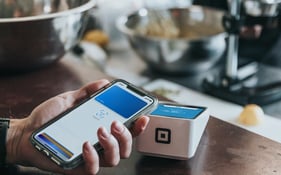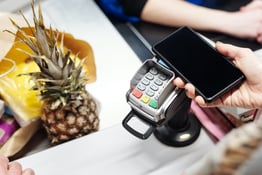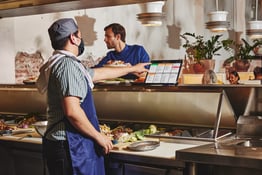One of the world’s first fully autonomous robotic restaurants opened for service last month in San Francisco. The concept, Mezli, founded by three Stanford engineering graduates, was born out of a desire to create high-quality meals at more affordable prices. Stroll up to the windowless blue-and-white box, and you’ll find several ordering screens where you can scan a Mediterranean-inspired menu conceived by Michelin-star chef Eric Minnich. Bowls start as low as $6.99.
“I was a grad student when I started to think about one of the biggest day-to-day problems that I was having in my own life, and that was not being able to get a quality, affordable meal unless I wanted to cook it myself,” says co-founder Alex Kolchinski. “I ended up doing a lot of meal prep, making a gallon and a half of dinner at a time on Sunday nights in my Instant Pot.”
Kolchinski found himself on a mission to change that, not just for himself but the community at large, diving heavily into research about why exactly restaurant food, especially healthy restaurant food, is often so expensive in the U.S. Kolchinski started sharing his learnings with friend Alex Gruebele, who soon after tagged Max Perham, together creating a team that combines backgrounds in artificial intelligence, robotics, and aerospace engineering.
Within two years, the trio opened Mezli. The goal is to expand nationwide. We sat down with Kolchinski to learn more about how the team’s automated technology works and how it trims many of the costs borne by traditional restaurants.
type: embedded-entry-inline id: 6uBW0Guh3aVK2Y9t9VgJJn
Before you started Mezli, what were you identifying in your research as the main reasons that restaurant food in the U.S. couldn't be more affordable?
One is the cost of building a restaurant. If you look at the public numbers from chains like Chipotle and Starbucks, they're spending over a million dollars to build each location. That's money that has to get paid back eventually, so that gets passed on in the form of higher food prices.
The other big piece is restaurant labor. Part of it is just the cost, and part of it is the unavailability now where restaurants are having a really hard time hiring, and that's getting passed along in the form of higher prices as well. We realized that a lot of this labor isn't really directly associated with the quality of the food. The labor that goes into the quality of the food is in the kitchen, which for today’s chains is offsite. That's where most of the important cooking is happening. Onsite, there's a lot of just taking money from customers and handing them things. That isn't the most appealing job in the first place, and it’s very expensive to pay people to do it. We realized that by automating a lot of this work, we could keep people in the kitchen doing the work that makes the food good, and then serve customers at a lower price point.
So it sounds like there’s still a fair amount of human-executed prep work and restocking involved. How many people are required to operate Mezli?
Right now, we have people onsite to talk to customers, explain what we're doing, and to keep an eye on the robot. But onsite, we don't typically require anyone.
Offsite, we work out of KitchenTown in San Mateo, which is a commissary kitchen, prototyping space, and office for us. We have a few people at a time in the kitchen. We’re only on our 10th day, but so far we’ve been serving between 150 and 300 meals per day, three days a week that we're open, and we're looking to bump that up to six days a week.
We also need someone for a few hours a day to bring the ingredients up from the kitchen in a refrigerated van and unload them into the robotic restaurant and do some light cleaning.
Walk me through the technology side of Mezli. What’s going on inside that 250-square-foot box?
There’s no way to look inside right now, and that’s because we’re still filing some patents on the technology. But you can think of it as a small, automated assembly line. There’s actually a video of this on our website. When a customer orders a bowl, an empty bowl goes onto a conveyor belt and works its way down the conveyor belt as each ingredient the customer orders is placed into the bowl. About halfway through, there's an oven step. We have a combination oven that heats everything up and finishes cooking ingredients that weren't fully cooked in the central kitchen. After the oven, there's garnishes, toppings, and sauces. Finally, the bowl gets placed in a smart locker. There’s two lockers on the end. And then customers pick it up.
As part of your research prior to Mezli, you looked a lot at other people’s prototypes to identify what was and wasn’t working. What were some of the common threads of what you often saw not working?
Some companies have tried to use general purpose hardware, like robotic arms, and program it to basically do what a human would do in a kitchen. That's just a very, very complicated thing to get right. We were seeing problems with reliability, where maybe [the robot] could do something once but doing it 100 times in a row was extremely unlikely. We realized that building custom hardware to do exact tasks was a better way to go.
Then the other thing that we saw was companies were building partial automation – restaurants with some degree of automation, but still some degree of humans doing stuff. We didn't see very many advantages from that. It seemed like they were complicating things without being able to improve the economics. So another one of our distinctive choices was going full on and not having the humans involved in the ordering process at all.
What went into the decision to team up with a Michelin-starred chef to create the menu, and how important do you feel that is to your concept?
Crucial. We’re a restaurant, we’re selling food, and without the food we have nothing. We’re all foodies. We’re in this business to sell really good food at a low price, and without Eric and his culinary team – they’re as important as anything.
You’re currently able to serve bowls as low as $7. Are you open to sharing what your profit margin looks like?
We’re doing a 50% gross margin. Most restaurants are doing a 70% to 75% gross margin. Everything we save on labor, we're pretty much passing along to the customer in the form of lower prices.
Were there any ingredients or other limitations you found yourself having to walk back in order to stick to your current price range?
We designed the menu around what we wanted to serve at the price point we wanted to serve. Eric knows what he’s doing. There weren’t too many surprises there. We had almost the opposite case, where we thought that some things, like falafel, we wouldn’t be able to get to the level of quality that we wanted. Largely because Eric and the rest of the culinary team are very good at what they do, falafel’s one of our most popular items right now.
Bowl assembly lends itself well to automation. We’ve also seen numerous pizza prototypes start to emerge. Do you think there’s a day where technology advances to make more complex dishes? And in general, I’d love to get your thoughts on the future of automation in the restaurant industry.
I think this kind of automation is going to be the biggest and fastest in relatively simple formats of food that have big markets, so things like pizza and bowls specifically. Items like sandwiches and burgers are just physically harder to make by robots. But longer-term, I expect this to spread more and more, and at some point, it will expand beyond simpler [food] formats, but it’s just going to take longer.
If we're talking about 10 years in the future, I expect there to be a lot of automated bowls and some other concepts, but still plenty of stuff being made by hand. I expect full-service restaurants to stay largely human-powered because it's much more about the social experience in the context of a sitdown restaurant.
In limited service restaurants, where the automation can handle the physical tasks, the economics are really compelling. You can just do a lot more, and focus the human staff in places where they can really improve the quality for the customer instead of just doing this repetitive work. We're also going to see a lot more iterative automation, and you're already seeing this. Lots of chains are deploying ordering kiosks, and some are experimenting with pickup lockers. That’s also a form of automation if you think of automation as a technology that reduces the amount that people have to do themselves.
I know it’s early days, but how has your restaurant been received by customers so far?
We’ve been getting positive reviews and hundreds of customers on days when we’re open. We're starting to pick up regulars. Our number one returning customer has already been here seven times — almost every single day we've been open. I think the quality and the price of the food is what’s resonating with people, which is exactly what we were going for.
Are there any adaptations you’ve had to make in these first couple weeks or any key learnings so far?
What's funny is that physical signage has been the most important thing. We were so focused on getting the robotics right, and the quality of the food and the price point right, that there were a few things we overlooked. For example, it wasn’t obvious to people that they had to walk around to the other side of the unit to pick up their food. Now we have a sign that says “pick up here”. We still do have to do some explaining. People are used to interacting with a restaurant in a certain way.
Are you open to sharing how much it costs to build out your current model?
It’s a custom enclosure, and we’re under half of the built cost of a Chipotle location already, and it’s going to go down substantially over time.
Given the economics, I imagine it’s only a matter of time until you expand. Where do you see Mezli going in the future?
I think these could be in lots of places, like mall parking lots, hospital parking lots. These are smaller and cheaper than restaurants, and they can go anywhere on a truck. We can try out locations without the risk of having plowed a million dollars into a location that fails because we can move Mezli. And then it’s also about being able to go places where restaurants can't go because there's not enough demand to support a traditional restaurant. You can imagine places like food deserts and highway rest stops, where it's not really viable to put a Chipotle right now. We’ll be exploring that in the future. We're also working on a form that could go into retail shells to basically be where traditional restaurants would be, but it's still an automated unit.
We're starting with Mediterranean food, but we're exploring ways to add more menus in the future. Our system’s set up to be totally modular, so if we wanted to start serving salads or burrito bowls tomorrow, it would be a pretty straightforward [software] update. We're looking to lean on that in the future to create more variety for our customers. But we’re focused on getting the first concept right first.
Grace Dickinson is a reporter at Back of House. Send tips or inquiries to grace@backofhouse.io.
[Photos courtesy: Albert Law, first, and Allison Busch, second]





